Industrial Revolution
%%Era of technological advancement%%
”==Industrial Revolution==” refers to the %%technological advancement in the West%% between @@Mid-18th to late-19th@@
The advancement brought huge change in the ==economic and social development.==
This period was a key stage of the rise of modern Europe
Here are the following features:
==Mechanization==
People would invent and use new machine to %%replace human power and animal power%% to increase production speed.Therefore, this period is also call “@@the Age of Machines@@”
==Industrialization==
Industry had grown rapidly and surpassed the ==traditional agriculture== (farming) as the main pillar of a nation’s economy
==Urbanization==
A large amount of farmer moved from the countryside to work at the industrial towns.
Which made the urban population increased and urban area to expand
<<Mechanization led to Urbanization led to Industrialization<<
%%Cause of the Industrial Revolution%%
1) Rise in population
@@In the 18th and 19th centuries@@, the population of Europe grew rapidly, which provide ==labour== for the development of industry and trade.
It also made %%the local demand for goods%% increased which encouraged mass industrial production.
2) development of world trade
@@From the 15th century onward@@, world trade centred on Europe grew rapidly.
Therefore, the global demand for good increased and in order to meet the global demands for ==manufactured goods==, Europeans introduced new machine and technologies in production
3) Accumulation of capital
%%European merchants%% gained a lot of ==capital== from ==foreign trade== and then they largely invested on new machines as well as %%technological innovations%% to increase production and earn higher profit
4) Development and application of science
@@After the Renaissance and Scientific Revolution,@@ Europe had greatly advanced in ==science.==
With %%the support of merchants%%, European scientists could be able to apply their knowledge improve the industrial technologies.
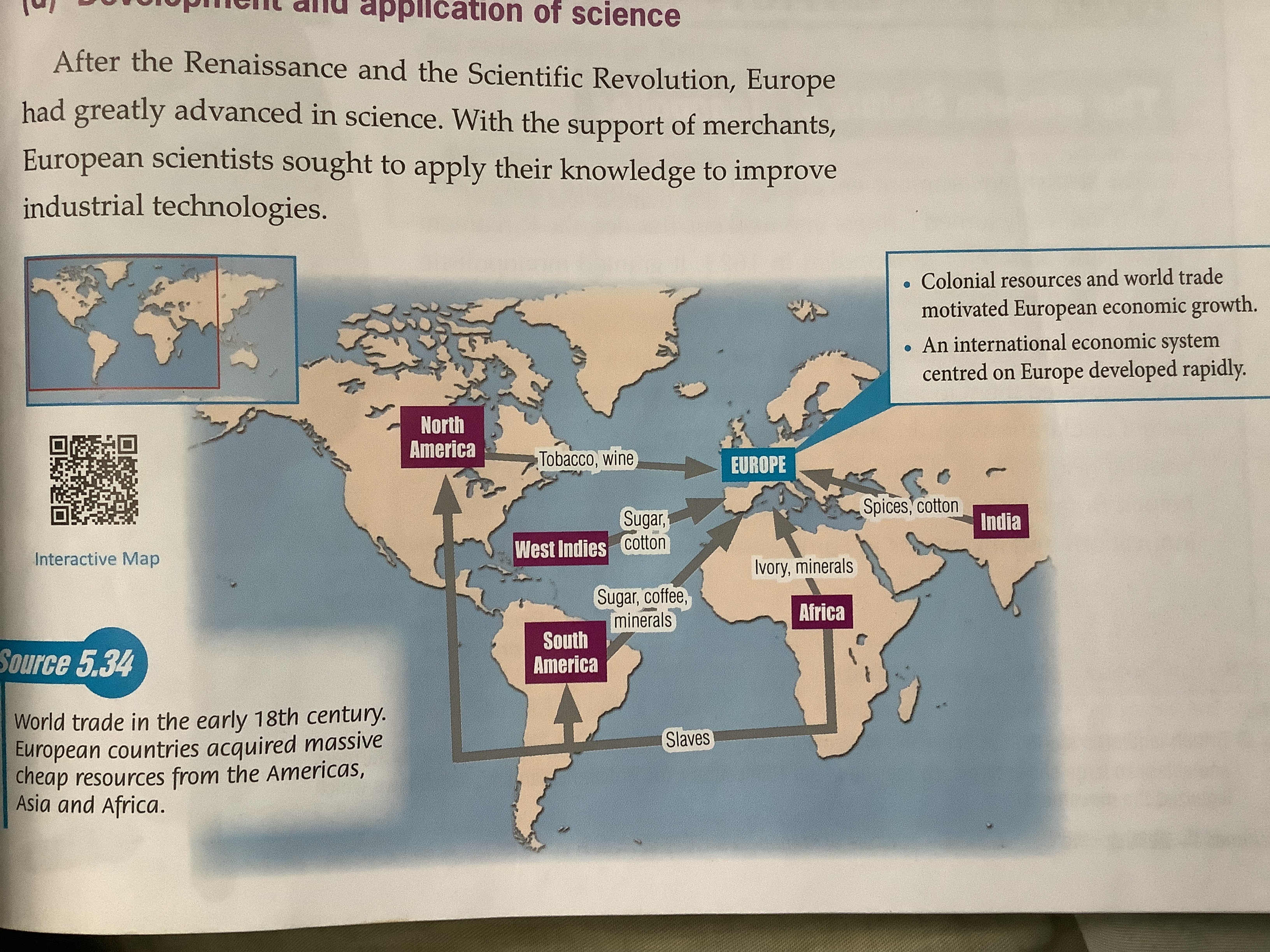
Why did the Industrial Revolution start in Britain?
1) Rich in natural resources and large overseas markets
Britain was rich in %%natural resources%% such as ==coal and iron==. Also, in the early 18th century, Britain had many ==oversea colonies== which Europe would ==exploit== for their own interest.those colonies provided %%cheap raw materials%% and %%oversea markets for Britain’s industries%%.
2) The Enclosure Movement
Owing to the ==Enclosure Movement==, %%many British farmers lost their farmland%%. They moved to cities and worked in factories. They became the major labour force of Britain Industrialization.
3) Government support for technological innovations
@@In 1623,@@ the British government passed a @@patent law@@ to %%protect the rights of inventors%%. It also sponsored ==the Royal Society== to %%carry out scientific experiment%% which made the scientific and technological had rapidly progressed in Britain.
Major development during the Industrial Revolution
@@Around 18th century@@, the Industrial Revolution started in ==Britain==. ==The textile industry== was the first industry to be %%mechanized%%. Later, the revolution spread to %%heavy industries%% such as ==iron and steel making, mining and shipbuilding== with %%the invention of the steam engine%%.
<<Also, the revolution had spread to other European countries, United States and Japan<<
In early I.R. ,the invention was mainly focusing on ==production==
E.g. steam engine, power loom, ==spinning Jenny==, clock (weaving machine)
However in late I.R. ,the invention was more likely focusing on the ==convenience in life==
E.g. Light bulb, ==electricity & oil==
1) starting of Industrial Revolution: Textile Industry
@@In the mid-18th century@@, British invented and improved ==textile machine== which were usually operated by the worker in the factories. Also, the form of production changed from ==domestic system== %%(production was done at home using simple hand tools or basic machines) to%% ==factory system.==
<<The industrial Revolution started, and gradually spread to other sectors.<<
2) using new source of energy
@@Before Industrial Revolution@@, Europeans mainly used ==humans, animals, wind and water== as energy sources. @@During the Industrial Revolution@@, they developed %%new energy source%% to drive larger machine for higher production ==speed and quality==
- Early state (==Steam Age==) : steam power
Steam power was the driving force behind the Industrial Revolution. @@In the 18th century@@, ==Watt== %%improved the steam engine%% from ==Newcomen== which was widely used in %%textile production%%, mining and ==transportation== (==steam locomotive==) later on.

- Later stage :electricity, oil and coal gas
Although battery was already invented in 1880, electricity wasn’t a major energy source .
@@In the 1870-1880s@@, American scientist ==Edison== invented the ==light bulb== and established the world’s %%first electric power system that provided durable electricity supply.%% This allowed factories to operate longer hours and increase production.
<<==The Age of Electricity==<< <<started.<<
@@In the mid-19th century,@@ oil was discovered as ==a high-performance fuel== just like electricity that could use to power up machine for production.
@@In 1865@@, ==the United State== laid %%the world’s first oil pipeline%% and %%established the oil industry%% and many European also established oil industry later on.
@@By the end of the 19th industry@@, oil had replaced steam as the primary energy source for Industrialization.
Meanwhile, European mined coal for %%generating steam and coal gas%% for ==gas lighting== and ==cooking==.
3) Development of coal mining and iron making
@@Before the Industrial Revolution@@, the coal mining industry depended on ==manpower==. Beside, people preferred ==cast iron== as an industrial materials instead of %%high-quality materials%% like ==wrought iron== and ==steel== due to economic factor
@@During the Industrial Revolution@@, people used ==steam power== in mining which improved the production efficiency. Also, the %%new iron-making technology%% further %%reduced the cost%% of ==wrought iron and steel== which turn them into the commonly-used industrial materials.
4) Improvement on transportation
@@Before the Industrial Revolution@@, %%roads were poor%%; traditional ==ox-cart, horse carts and sailing ships== were the main means of transport.
@@During the Industrial Revolution@@, innovation (==mule cart==) in transport infrastructure and mean‘s of transport raised transport efficiency greatly.
- Land transport
The ==“Macadam Road”== which was %%flatter and had better drainage%% was developed. European invented ==steam locomotives== and started to %%build railway networks%% to transport goods and labour. The ==“Age of Railway”== began. With the world’s first car emerged in @@1883@@ (Benz), steam locomotives and cars became the two major means of land transport.
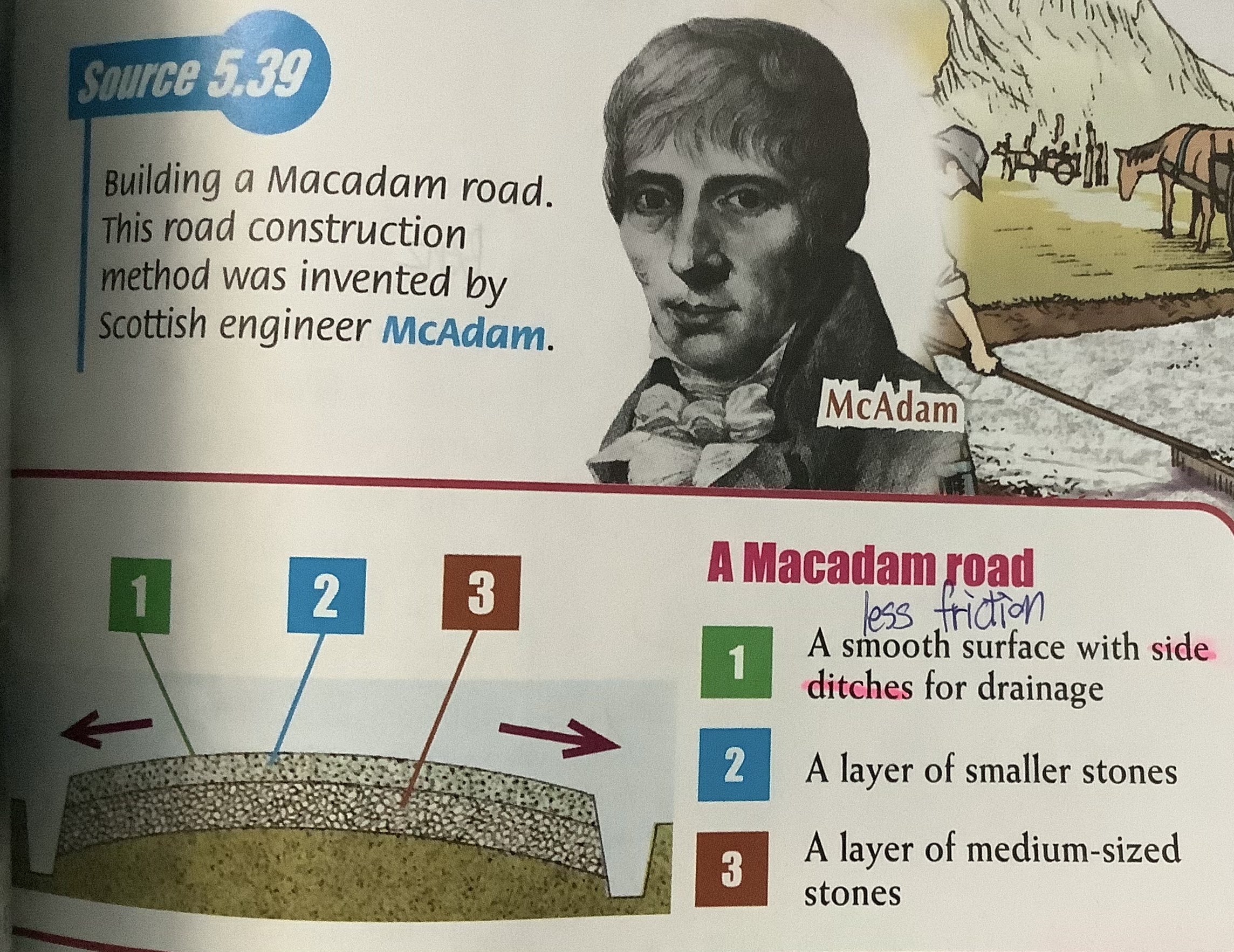
- Sea transport
==Canals== were built between industrial towns to transport cargoes more efficiently and economically. Europeans also %%invented and improve steamships%% to carry more passengers and cargoes further and faster.
5) Advancement in communication
@@Before the Industrial Revolution@@, people delivered messages by ==post== which took a long time.
@@During the Industrial Revolution@@, Europeans and Americans invented ==telegraph== and the “==Morse Code==” for %%military purpose%% and telephone and also %%built telephone network%% for faster delivery of messages.
6) Advancement in medicine
@@Before the Industrial Revolution@@, there was %%little knowledge of social medicine%%.
@@During the Industrial Revolution@@, ==hygiene== was very bad in ==slums==. Then, doctor started to study ==social medicine==. There were breakthroughs in the prevention and treatment of diseases.
- Prevention of diseases
==Vaccine== against ==smallpox, cholera and rabies== were invented.
[==Jenner== invented %%the world’s vaccine%% which was vaccine for ==cowpox==]
- Treatment of diseases
==Pierre== and ==Marie Curie== discovered ==“radium”== which was ==radioactivity== and could be used to treat cancer; ==Rontgen== discovered ==X-rays== which allowed doctors to %%obverse patients’ bodies%%
- Nursing of diseases
==Antiseptic surgery== was used which could prevent ==septicaemia== caused by bacteria.
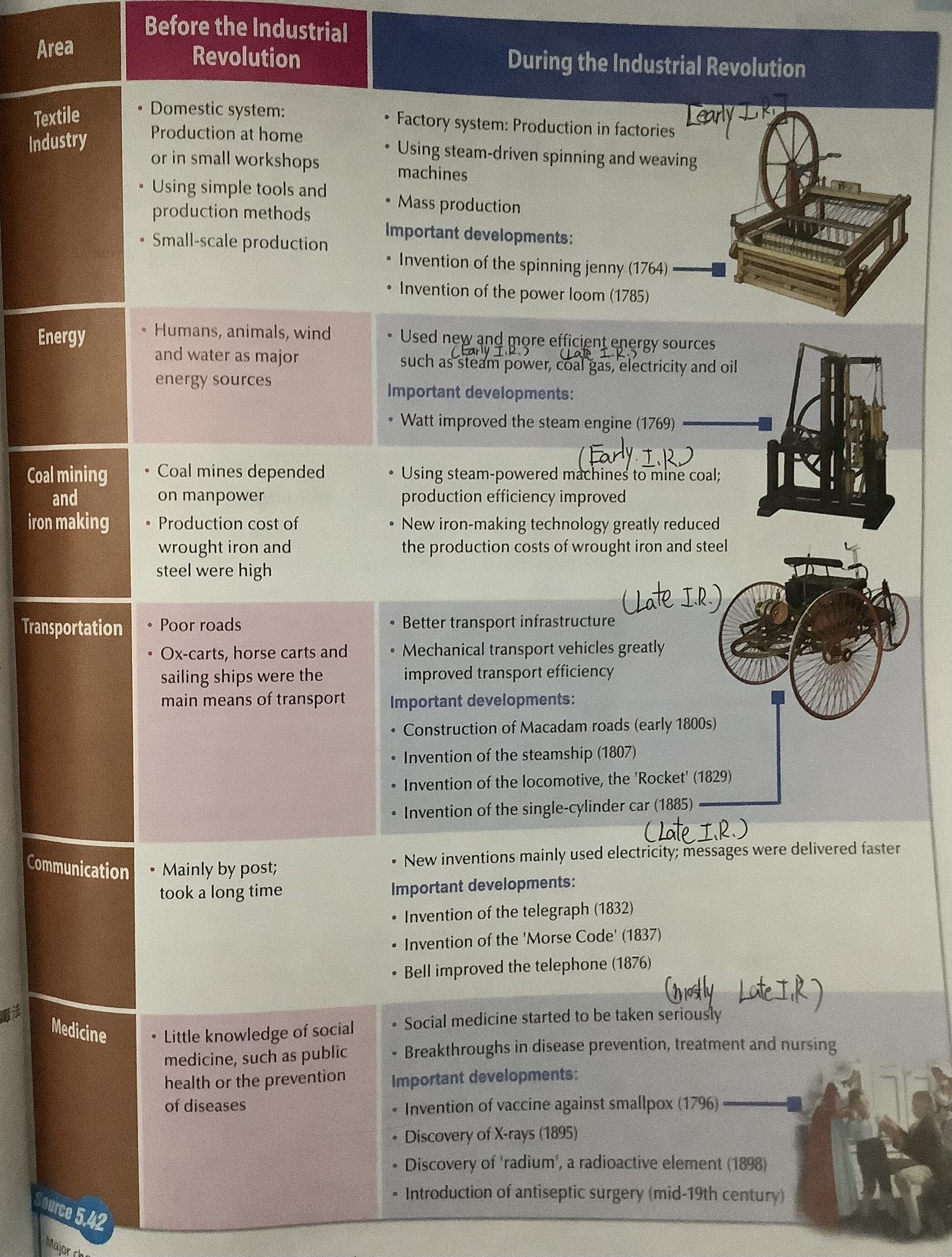
Impacts of the Industrial Revolution
The Industrial Revolution prompted those Western Countries to speed up overseas expansion which gradually manipulated the development of global politics.
1) The rise of modern capitalism
@@During the Industrial Revolution@@, people who owned %%the means of production%% such as machines and mines became ==capitalists.== They %%put their privately-owned properties into production%% and further expanded the production capacity through the ==factory system== and ==joint-stock companies.==
- Rise of the factory system
@@During the Industrial Revolution@@, capitalist %%built factories%% and i%%nstalled expensive and large machines%% then %%employed many worker%% to operate the machine to carry out mass production. This mode of production is called “==factory system==” and it replaced the domestic system and became the main mode of production.
In a factory, the production process was separated into many ==specialized parts== and each worker %%was assigned to a single part of it%%. This is known as “==division of labour==”
@@As workers repeated their work continuously@@, they became %%more skilful%% in performing their job which helped to save time and improved the quality of work.
- Development of joint-stock companies
Many capitalist wanted to increase their industrial productivity, but %%the cost of operating machinery and factory%% was high. Therefore, more capitalist would set up ==joint-stock companies== and produced ==stocks== and bonds to ==raise== capital.
Joint-stock companies allowed capitalists to %%expand their production capacity%% and further promoted the rise of modern capitalism.
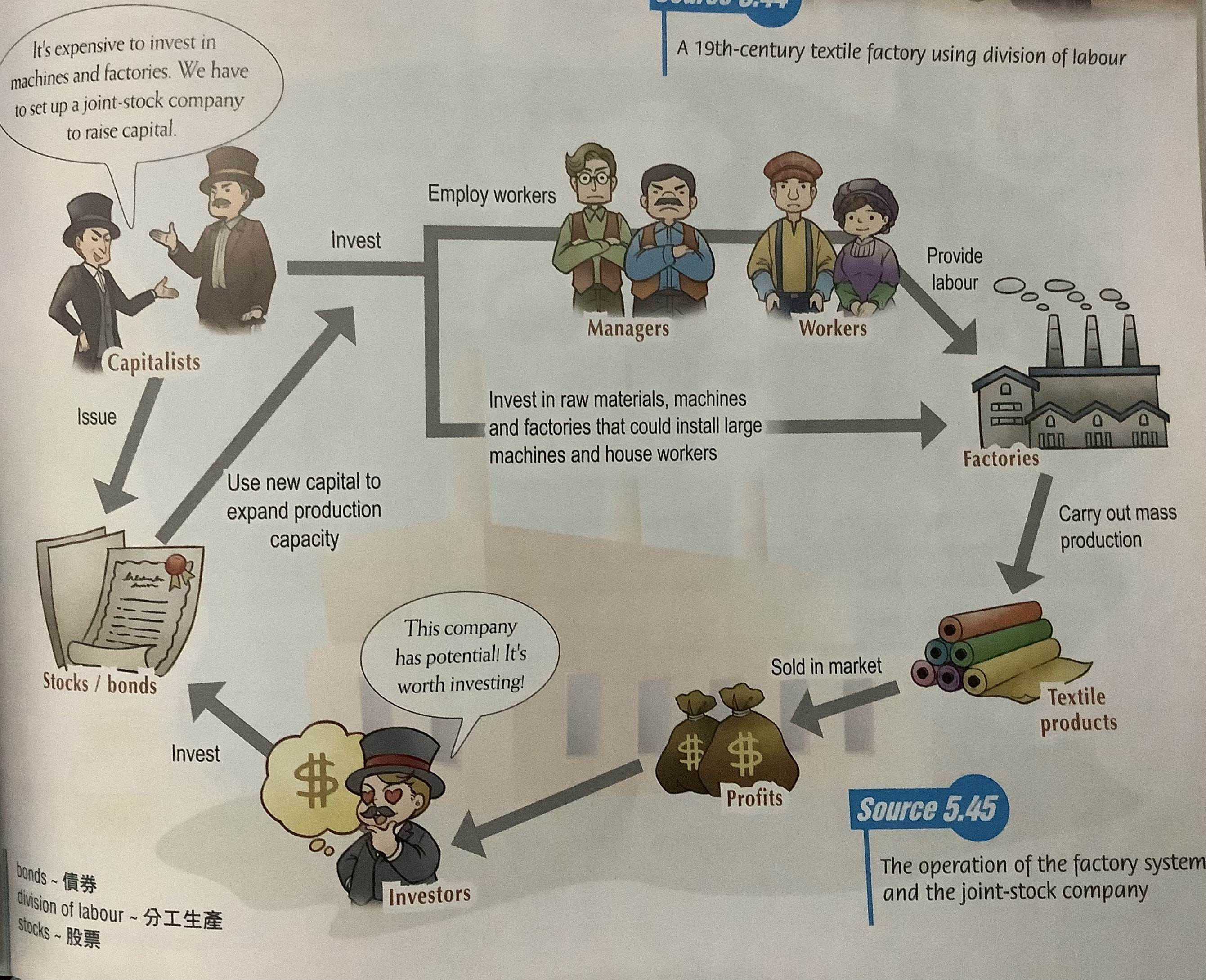
2) Growth of Industrial Towns
@@Before the Industrial Revolution@@, most Europeans %%lived in the villages.%%
@@During the Industrial Revolution@@, farmers who wanted higher wages moved to live near the factories with their families. This led to the growth of industrial towns.
Their population continued increase and their areas continued to expand.
@@By the mid-19th century@@, there were a large number of industrial towns in Britain.
Urbanization first occurred in Britain where the industrial Revolution started. With the spread of the Industrial Revolution, urbanization also occurred in other European and North American countries.
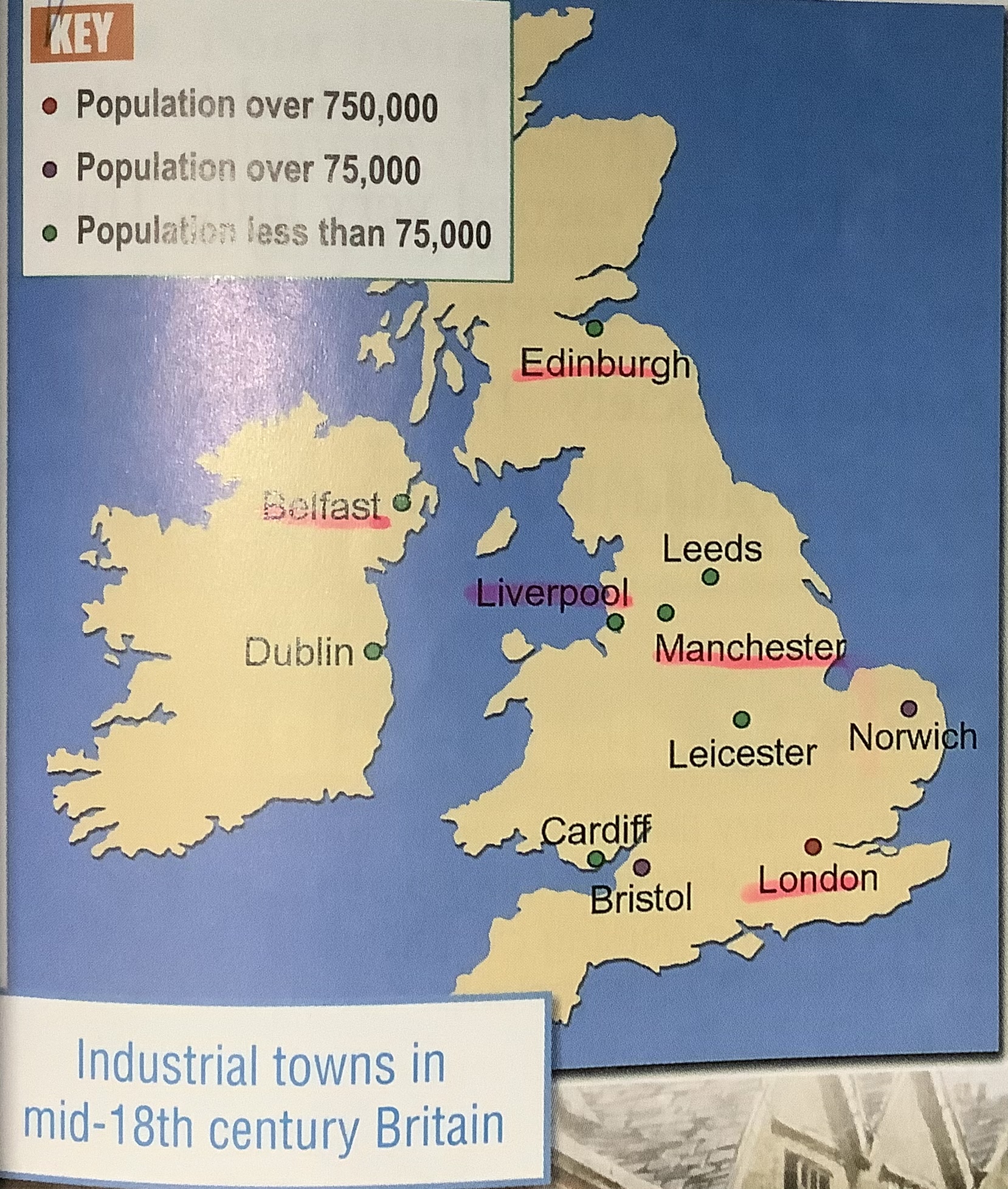
3) Rise of new social classes
Before the Industrial Revolution, there were two major classes in Europe; the nobles and peasants. The Industrial Revolution saw the rise of new social classes:
- The capitalist class:
It included ==industrialists==, ==businessmen==, and %%owners of factories and mine.%%
They were rich and could influence government policies.
- The middle class:
it mainly included lawyers, doctors and engineers which %%weren’t involved in the production process%%. They accumulated wealth because of ==their professional knowledge== and ==expertise==. They were not as wealthy and influential as the capitalist class.
- The working class:
It %%worked for the capitalists%% and earned very little. This group of people were poor and at the bottom of society. The working class was also called the “==proletariat==”
4) Labour problems an government responses
a) Labour problems
@@During the Industrial Revolution@@, the ==wealth gap== between the capitalist class and working class continued to widen. The capitalists were very wealthy whereas the workers had a hard life.
- Low income:
Workers’ wages (per day) were low. Women and children had to work in factories and mines to %%earn extra income.%%
- Long working hours and frequent accidents:
Workers had to work about ==14-15 hours== every day. Few factories or mines had safety measures. Industrial accidents occurred frequently.
- Poor living conditions
Most workers %%lived in crowded slums%% in cities. The %%poor living and sanitary conditions%% made it easy for diseases to spread.
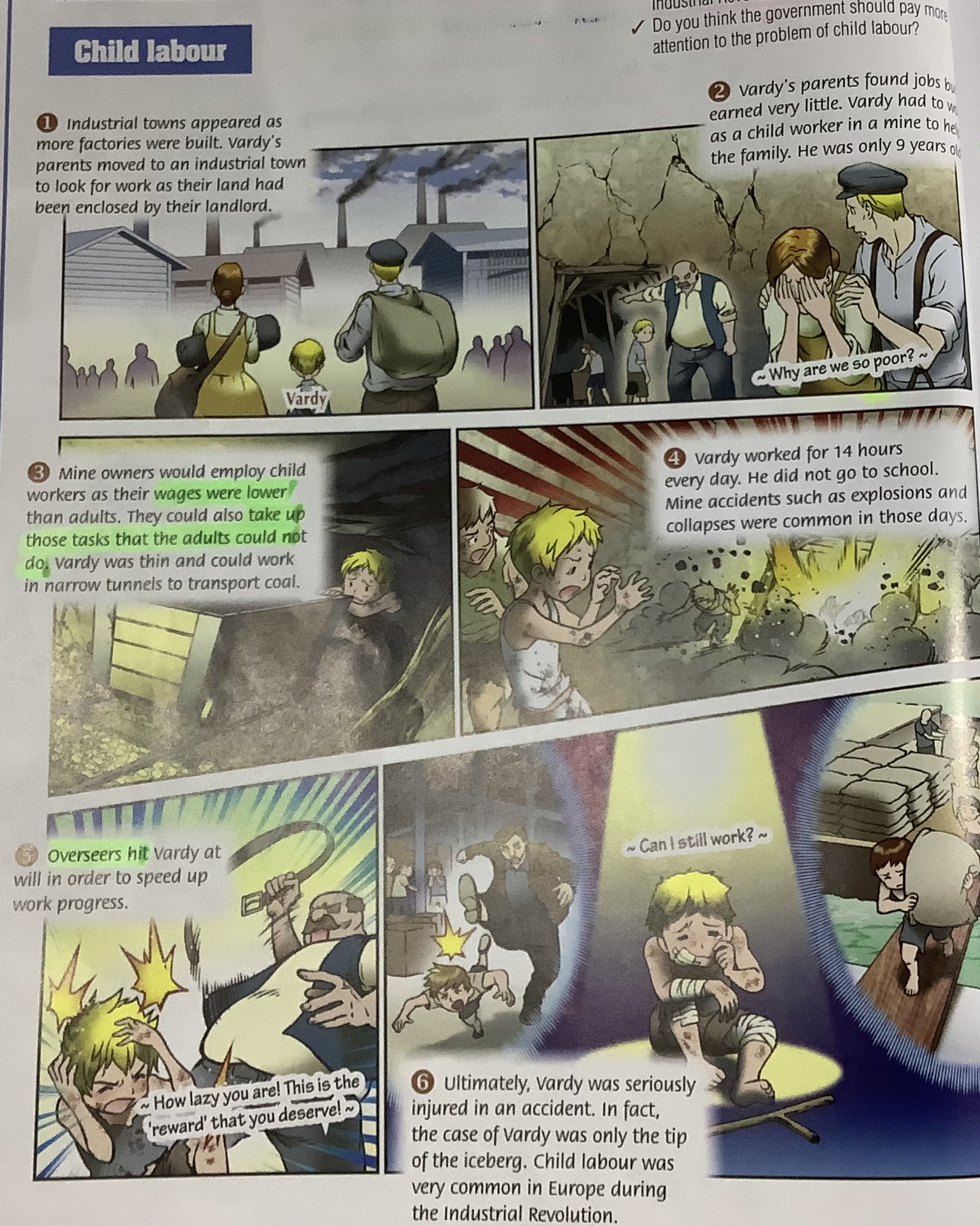
b) Labour movement and achievements
Worked tried to improve their conditions and wages by forming trade onions. @@In 1824@@, the Briti sh government %%recognized the legal status of the trade unions%%. @@Between 1838 and 1848@@, trade onion in Britain organised the ==“Chartist Movement”== to %%demand shorter working hours and higher wages%%. They also demanded %%the right to vote for every man above 21 years old%% . They wanted %%their representatives to take part in government affairs%% to protect their interests.
@@Starting from the 1830s@@, the British government %%passed a series of acts%% to improve workers’ conditions, including %%legislation for standard working hours%% and prohibition of child labour in mines. Workers’ condition in other countries didn’t prove much until the early 20th century.
Rise of Socialism
a) origin of socialism
Capitalism, cause by the Industrial Revolution, gave rise to new idea.
Some thinkers criticized the ills of capitalism; %%private ownership of property%% allowed a few capitalists to %%control the means of production%% and %%exploit the working class for profit%%
Therefore, they advocated that %%the means of the production should be owned publicly,%% and %%wealth should be redistributed equally%%, these ideas are called “==socialism==”
B) Development of socialism
Among the different schools of socialism, the ==British Owen’s== and the Frenchman ==Saint-Simon’s== “==Utopian socialism==” ;and ==Germans Engels’== and ==Marx’s “communism”== were the most representative.
Also Engels and Marx wrote the ==Communist Manifesto== together @@in 1848@@ which encouraged the working class to overthrow the capitalist class and set up a socialist government
With the spread of the Industrial Revolution, socialism spread to many countries. Marxism (communism) which gained the most attention greatly affected the development of the West and the world.
Further expansion of world trade
@@After the start of the Industrial Revolution@@, industry and commerce in Western countries developed rapidly. The Western industrial powers (Britain, France, Germany, and the US) imported %%large quantities of raw materials%% from different places (their colonies, trading partner) for domestic production and ==exported manufactured goods.== Improvement in transportation and communication also led to the rapid development of international trade and technologies exchanges.
Economic and colonial expansion of Western countries
The Industrial Revolution strengthened the economic and technological power of Western countries, encouraging them %%to acquire more raw materials%% and %%open more overseas markets.%% They made use of their supremacy to speed up economic and colonial expansion in Asia and Africa. This new tide of colonial expansion is called ==“New Imperialism”==
@@By the early 20th century@@, Western countries had set up many colonies in ==Asia== and ==Africa.== %%An international economic system centred on the West%% gradually emerged. However, colonial competition caused many ==conflicts== among the Western powers. The international situation became tense.
